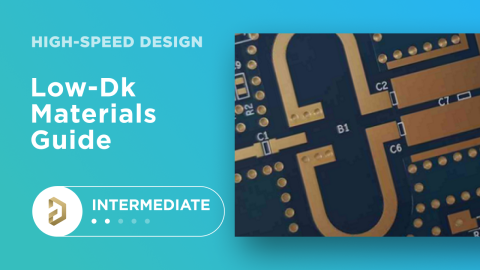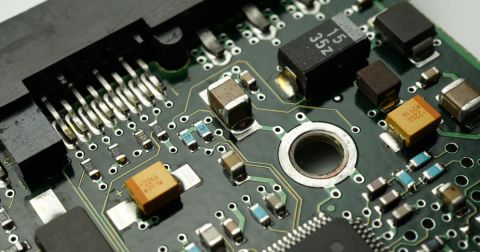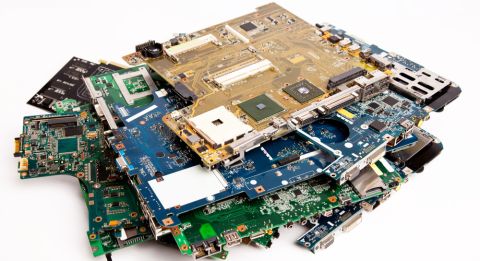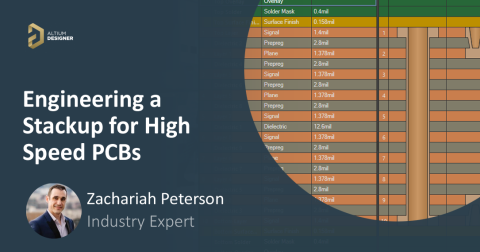How to Use AC Coupling Capacitors in High-Speed PCBs

High-speed interfaces like TX and RX lines for SFP connectors, PCIe lanes, and Media Independent Interface (MII) routing use AC coupling capacitors between drive and receive components. AC coupling capacitors perform a simple function: they remove DC bias from a differential signal so that the differential voltage sensed at the receiver is within a certain range. The receiver can restore its own DC bias offset on the received differential signal as part of its on-chip or external termination circuit. This differs from DC coupling with matched resistors, where each side of the circuit needs the DC bias, but there is no mechanism on the received chip to set the bias internally at the receiver.
The big debate around AC coupling capacitors and how they should be used in high-speed channels falls into two areas:
- Where should the capacitors be placed? Is it close to the driver, close to the receiver, or does the placement not matter?
- Should a ground cutout be placed below the capacitors? Should this pass through the entire stackup and act as a routing keepout for all other signals?
I'll look into these points in this article. My position is clear and is in line with other SI experts who have talked about this matter. If the termination at each end of the link is within the channel bandwidth, then the location of the AC coupling capacitors should not matter. Of course, there are slight deviations in quality of termination at each end of the link, as termination is never perfectly at the target impedance, so there may be slight deviations from this behavior in real channels.
Selection of AC Coupling Capacitors
AC coupling capacitors, when placed on a differential transmission line, look a lot like an impedance discontinuity as a function of frequency. At very low frequencies, the AC coupling capacitors appear to present a very large impedance, thus blocking low-frequency portions of a signal. At very high frequency, the AC coupling caps appear to be transparent to the signal, so the input impedance looking through the AC coupling capacitor looks like the transmission line impedance. Barring any other parasitics from the pads on the capacitor or the capacitor’s ESL value, we would expect AC coupling capacitors to pass maximum signal at very high frequencies.
This brings us to a few simple capacitor selection and placement guidelines which are valid in AC-coupled differential channels:
- Place the capacitors symmetrically along the differential pair, and fan out the traces into the package if needed.
- Select a package size and footprint that does not exceed the width of the traces in your differential pair.
- Keep a preference for smaller package sizes as these will have lower ESL value.
- Typical capacitor values are 10 nF or 100 nF.
Next, let's look at placement guidelines and see if the guidance can be contextualized.
Location of AC Coupling Capacitors
The factors listed above address AC coupling capacitor selection, but they do not address the location where the capacitors should be placed. Guidance on this point also varies widely by semiconductor manufacturer, and the guidance from experts can often lack context. To see where these capacitors should be placed, let's look at test data and simulation data which may support a decision to place these components at the driver, receiver, or anywhere in between.
AC Coupling Capacitor Test Data
First, let's look at some test data showing eye diagrams on a differential channel that uses AC coupling capacitors at the driver and at the receiver. The images below show test data provided by EverExceed; this test data compares the two situations using eye diagrams. In each case, AC coupling capacitors were placed along a 4.1 inch interconnect, and the AC coupling capacitors were placed 100 mil from the driver or receiver respectively.
Test data can be found at EverExceed. NOTE: In my opinion, this experiment is incomplete and one should not make generalized statements about AC coupling capacitor placement.
In this eye diagram, it initially appears that the ideal location to place AC coupling capacitors is near the receiver. In the case of receiver-side AC coupling capacitor placement, there appears to be some edge rate degradation along the rising edge of the incoming signal. There appears to be no change in jitter or overall noise level once the signal settles.
While I don't deny the accuracy of the measurements, it is very difficult to conclude that only the location of the AC coupling capacitors produces the edge rate degradation observed in the eye diagram. A more thorough experiment would have varied more parameters and examined the eye diagrams in each case in order to eliminate other possible causes of the differences in these diagrams:
- Vary the size of the trace width and spacing compared to the capacitor landing pad size.
- Vary other factors in the differential pair design, such as trace-to-trace spacing.
There are two other factors that were not examined in this particular experiment, which is usage of a ground cutout below the capacitor and whether the termination matches target impedance within the receiver’s required bandwidth (up to the Nyquist frequency). It is sometimes stated that this is necessary for AC coupling capacitors in order to produce reflection. Fortunately, that has been examined in simulation, which we show in the next section.
Simulation Results From Simbeor
Readers may remember Yuriy Shlepnev from our podcast episodes, where he has demonstrated the capabilities of Symbior's simulation software. Symbior is an excellent tool for simulating high-speed signal integrity, and some of its models are built into the layer stack management in Altium.
One of Yuriy's application notes deals with the topic of AC coupling capacitor usage on differential pairs. Several situations were examined in his application note:
- Usage of large case capacitors versus small case capacitors
- Examining forward and backward return loss to determine reciprocity
- Examining usage of a ground cutout below a capacitor
I won't bore you with the simulation details and will instead refer readers to his application notes; links are found as citations on the images shown below.
The big takeaways from Yuriy's work are as follows:
- Forward and backward propagation give identical insertion loss spectra; AC coupling capacitors are reciprocal.
- Different terminations on each side of the AC coupling capacitor give different return losses, meaning now the placement does matter because the placement will determine input impedance on each side of the capacitor.
- Identically terminated channels give the same return losses, meaning placement doesn't matter.
- Smaller case capacitors with pads closer to the trace width appear to give lower reflections due to smaller impedance mismatch.
Regarding the first point, insertion loss results show identical insertion loss curves in the forward and backward directions along a coupled capacitor. The results also show identical group delay, which is exactly what one would expect for a reciprocal channel.
S-parameter data confirming reciprocity of AC coupling capacitors with and without ground cutouts. View these results in a Simbeor application note.
The important return loss results relating to usage of a ground cutout and package size/SMD pad geometry are shown below. It should be quite clear that usage of a ground cutout appears to provide a better match to the input impedance downstream from the capacitor, which is illustrated by the lower return loss for the case with the ground cutout versus without the ground cutout.
S-parameter data comparing 0402 and 0603 capacitor sizes with and without ground cutouts. View these results in a Simbeor application note.
The ground cutout recommendation is also somewhat contentious and has been deemed by some high-speed designers to be unnecessary. I tend to trust simulation results that easily lend themselves to checking in an experiment, although at the moment I'm not aware of experimental data that looks specifically at the issue of having a ground cutout. I would also expect the ground cutout only matters above certain frequencies, something which is implied in the above simulation results.
It's All About Input Impedance Mismatch
An important point regarding AC coupling capacitor placement is that the capacitors do not impact channel reciprocity. Capacitors are passive linear circuit elements, so we would naturally expect reciprocity for signal propagation through AC coupling capacitors. Channel reciprocity gives us the following relation in terms of S-parameters:
S-parameter relationship for reciprocal channels
In other words, transmission through a channel is the same regardless of direction. This means that if we placed a coupling capacitor, and we swapped driver and receiver, all the S-parameters would be identical as long as the input impedance on each side of the capacitor was matched within the channel’s bandwidth requirement. We can see this from some of Yuriy Shlepnev's simulation results in his application note.
Based on simulation and our own intuition, forward and backward propagation through the capacitor will be exactly the same. Therefore, the placement of the capacitor and its mounting geometry should be the only factors impacting signal propagation, as these would influence reflections, and this would be seen in a return loss simulation or measurement.
Whether capacitors should be placed near the receiver or near the transmitter depends on a simple factor: whether the AC coupling capacitors create excessive impedance mismatch in the high-frequency range up to the channel bandwidth. The placement is appropriate when the input impedance looking through the capacitor towards both the driver or receiver matches the channel's target differential impedance value. I have illustrated this in the diagram below.
There is an input impedance looking through the coupling capacitors, which will be dependent on the characteristics of the capacitor, the input impedance at the receiver, and the distance to the receiver.
I think this leads to three situations in particular where the placement of the AC coupling capacitor does not matter at all:
- Below about 2-3 GHz, any placement location is appropriate.
- In a very long channel, where placement is not too close to the driver or too close to the receiver, it should not matter where the coupling capacitors are placed.
- When the channel is perfectly impedance matched at both ends within the channel bandwidth, any placement is fine regardless of channel length. Yuriy’s insertion loss results above and the return loss results linked here (slide 26) confirm this.
- When the mounting geometry for the capacitors is not significantly different from the trace geometry, regardless of length and placement location.
The points in this list are consistent with results from Yuriy's investigations, which were performed at frequencies spanning 10’s of GHz.
Other Interesting Coupling Capacitor Placement Recommendations
The challenge with placement guidance from semiconductor manufacturers is that they never describe what the termination at each end of the link is in some components. They might tell you a specific location where it should be placed, but not much more than that.
Despite the loose guidance, there are a few examples where placement guidance and package selection are made very clear. Two in particular are worth mentioning:
- Placement of AC coupling capacitors on an add-in card, such as a PCIe edge card, where the capacitors are placed at the device end or connector end. (Source: Intel)
- Placement of AC coupling capacitors near hot-pluggable modules, such as fiber transceivers with SFP connectors. (Source: Dr. Howard Johnson, SigCon)
- According to HSPICE simulation results from Microchip, SMD package parasitics and landing pad geometries do not affect signal integrity up to a few GHz frequencies (Source: Microchip)
To learn more about this issue with AC coupling capacitors, watch our video on Altium Academy.
Whether you need to build reliable power electronics or advanced digital systems, use the complete set of PCB design features and world-class CAD tools in Altium. To implement collaboration in today’s cross-disciplinary environment, innovative companies are using the Altium platform to easily share design data and put projects into manufacturing.










